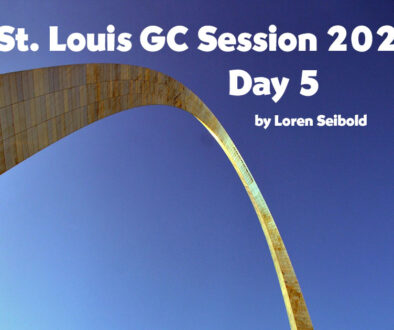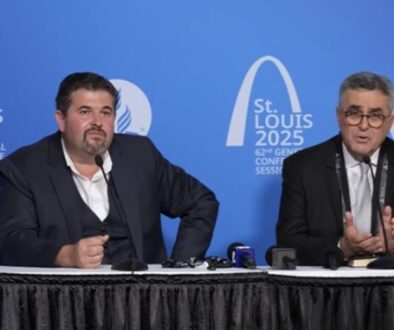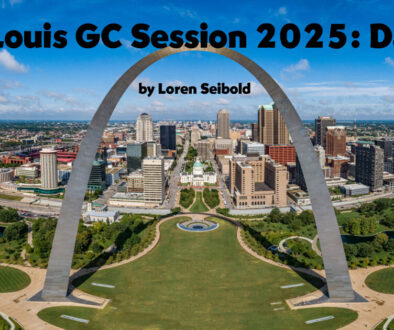Seven Adventist Mythologies That Are Delaying Christ’s Second Coming
By Pastor Tom Hughes, September 6, 2016: For over a century the Seventh-day Adventist Church has proclaimed a message based on the three angels of Revelation 14. The first angel symbolizes God’s last message of warning to a world that is soon to be ending when Jesus comes again. The Adventist Church sees itself as the unique religious movement that is warning the world of impending doom, and that understands what the Book of Revelation conveys about the last days. In spite of the unique importance of this message, many Adventists (though certainly not all) have missed the significance and eternal truth of the first angel’s message.
The first angel’s message is pre-eminent because it is repeated and intensified in the third angel’s message. (See Signs of the Times, January 25, 1910) Revelation 14:6-7 states, “And I saw another angel fly in the midst of heaven, having the everlasting gospel to preach unto them that dwell on the earth, and to every nation, and kindred, and tongue, and people, Saying with a loud voice, Fear God, and give glory to him; for the hour of his judgment is come: and worship him that made heaven, and earth, and the sea, and the fountains of waters.” These verses have an ominous tone that certainly gets one’s attention. This angel is pictured in the middle of heaven, like a satellite rotating the earth, suggesting that it comes from God and that it is visible to the entire world.
This angel is seen as carrying a message to everyone no matter where they live, in every country, culture and language. This message is proclaimed loudly to enable everyone in the entire world to hear it. It commands everyone to worship God and glorify Him. It is a “loud” message of worship! It is a message demanding that all the world worship the creator who made the “heaven, earth, sea and fountains of waters.” It symbolizes a movement that preaches the gospel and worships in all the world.
What is this movement preaching? The “everlasting gospel,” the time of judgment has come, and worship the Creator. Many Adventists understand this message and are sharing a Christ-centered, worshipful message about God’s judgment. However, not an insignificant number are preaching a false message because however well-intentioned they may be, they have missed the key elements of the first angel. This should not be taken as an indictment of the church, but rather as a challenge to those preaching a version of Adventism that is not supported in the 28 Fundamentals of our faith. A vocal and aggressive minority that often speaks loudest in our media and publications.
What are the Adventist mythologies that are keeping us from understanding the message of the first angel? When the Secret Service is teaching its agents how to spot a counterfeit bill, they spend hundreds of hours studying the real bills and almost no time studying the counterfeit. Let’s study the truths of God’s word that are the antithesis of these seven mythologies of Adventism.
The first mythology that has done terrible harm to the Adventist Movement is the heresy of perfectionism.
When asked the question, “Are we saved by faith AND works?” Adventists say yes far too often. They often have a Roman Catholic understanding of the gospel. Large segments of Adventists believe that works done by the Holy Spirit are meritorious. They say, “It’s not my works; it’s the Spirit’s works.” This is the same understanding Roman Catholics have concerning their works’ counting toward their salvation. Martin Luther and Ellen White taught we are sinful, yet holy. “Though guilty, he is looked upon as innocent. Christ fulfilled every requirement demanded by justice.” (White, The Youth’s Instructor, April 25, 1901. Compare to Luther in B. A. Gerrish, Grace and Reason: A Study of the Theology of Luther, p. 135.)
Too many of us are “Achievers” rather than “Receivers.” Even though we devoted an entire Sabbath School Quarterly to the gospel in Galatians, ever since 1888 the church has struggled with the concept that “by no works of the law shall any man be saved.” In a church where no Adventist has even kept a single Sabbath perfectly, we proclaim to the world that if they don’t they will be lost. Sadly, perfectionism and legalism is alive and well among us.
The second mythology is Harvest Theology.
This teaching of many leading Adventists, including editors of prestigious magazines and publications for over 50 years, is a teaching first espoused by M. L. Andreasen, an Adventist minister who had his credentials taken away. Many accepted the teaching and failed to see that it is a totally false concept that leads straight to an erroneous view of righteousness by faith. The basic premise is that before Jesus can come again, at least some Adventists have to reach a state of sinless perfection by character development, so that by the time Jesus steps out of the sanctuary in heaven, they are so perfect that they can stand before God without a mediator and live a sinless, perfect life until Jesus gets to Earth. The world will only be “harvested” when the church has achieved this state of perfection. It also teaches that Adventists must “vindicate the character of God.” (Only Jesus truly vindicates God’s character.) Ellen White declares, “No one is perfect but Jesus.” (White, That I May Know Him, p. 136)
The third mythology is a Catholic understanding of worship and reverence.
In the Roman Catholic Church reverence is defined as “silence” before God. Only the priests and higher officials of the church are allowed to speak. Many Adventists have accepted this strict interpretation of the word reverence. They believe that you should not speak out in church services. You are not allowed to praise God in a loud voice, not allowed to say “Amen” or “Praise the Lord.” You’re not allowed to raise your hands in the sanctuary. You’re not allowed to applaud when your brother or sister sings or plays an instrument that gives glory to God. You’re not allowed to shake hands or hug your fellow worshipper in the pew beside you. They have forgotten about the Jesus teaching that “It’s lawful to do good on the Sabbath day.” The Bible teaches a reverence that can be exuberant and even loud on occasion. Yet some embrace a formal, Christless, joyless, silent religion, where if you raise your hands, you’d better be asking a question! No wonder many of our children find our services so dull and uninspiring. God is pleased by and inhabits the praise of His kingdom!
The fourth mythology is the concept of Puritan Separatism, or an “Adventist Separatist” mentality.
Many of the early founders of the Adventist Movement were Puritan separatists. They had a very strict view of the world, often including things in their system of beliefs that were “extra-biblical.” In the area of dress they believed that wearing buttons on your clothes was vain, wedding rings and jewelry were “worldly” and that the church was a fortress to protect you from the world, rather than a hospital for sinners and a rescue station for the lost. We had to wear extreme fashions that demonstrated our “separation from the world.” We were not allowed to be joyful and exuberant in our worship, music and praise. We had to be extreme in our diet and lifestyle. Even though Ellen White was a shouting Methodist who repeatedly stated that we should “Shout the devil back” and be exuberant in our worship and praise of God, and not make dress a test, the “Adventist Separatists” contradict all that and more. While they give lip service to her as a prophetess, they go far beyond anything she ever said concerning conservative ideology. If Adventism were to continue to embrace this theology, they would soon become as irrelevant and culturally illiterate as the “Adventist Separatists” are today.
The fifth mythology is the false theology of a condemnatory judgment.
Even though the Bible repeatedly teaches that Jesus came not into the world to condemn the world, but that the world through Him might be saved, many teach that the primary purpose of the judgment is to expose those who are still imperfect because they have failed to achieve the necessary character perfection through “Holy Spirit Perfectionism.” This message of sinless perfectionism has driven off whole generations of Adventist youth, who are smart enough to realize that neither they nor their parents could ever achieve the necessary “righteousness.” For decades we have emphasized what we must do for God far more than what God has done for us. The judgment is all about what Jesus did, not about what we accomplish in our own works!
The sixth mythology is the doctrine of standing perfect without a mediator during the time of trouble.
Some among us preach the time of trouble so much that we become “troublemakers.” They teach that one day Jesus will throw down the golden censer and that when He does, all those remaining will have to live a perfect life without a mediator or they won’t be saved. Absolute sinless perfection must be “achieved” and they must live a sinless life, because if they do sin after Jesus steps out of the Most Holy Place, they will be lost. This heresy has been taught in our churches and Sabbath Schools for over fifty years. Many become so fearful of having to stand without a mediator they have lost their minds, left the church, or become perfectionists who are constantly striving to become so “holy” that they won’t need Christ anymore when He steps out of the Most Holy Place. They atomize sin and fail to see their sinful nature will remain until Jesus comes. (White, Signs of the Times, March 23, 1888; also Selected Messages, Volume 3, p. 355) Confusing sanctification and glorification, they misinterpret both. Every sin we will ever commit was fully paid for on Calvary 2,000 years ago. Jesus declares upon ending His priestly ministry, “He that is unjust, let him be unjust still: and he which is filthy, let him be filthy still: and he that is righteous, let him be righteous still: and he that is holy, let him be holy still” (Revelation 22:11). It’s impossible to be lost even though we are still sinful, with a sinful nature until Jesus comes. (White, The Youth’s Instructor, April 25, 1901)
The seventh way some have missed the first angel’s message is we have failed to share a judgment message that declares the saints “not guilty” and delivers them from sin and all its consequences.
We have missed the good news of the judgment and made it something to be feared and dreaded rather than embraced and celebrated. The gospel gives us our right to worship the creator, and our freedom from the consequences of our sins, declaring us “not guilty” and making us joint heirs with Christ. How have we failed? Because we preach the second coming of Jesus as a moment of condemnation, a judgment that will condemn those who insufficiently “achieved” a state of perfection that will “guarantee” their salvation. Those who “keep the wrong day” will be punished. Those who “still eat meat” will fail to make it through the time of trouble. This dark message of condemnation offers zero hope. No way out except getting on the treadmill of earning our own salvation. By not preaching the “hour of his judgment has come” as an hour to “receive” salvation as a free gift rather than a lifetime of futile “achieving,” we rob the gospel of its power and the judgment of its hope. Could it be that a church emphasizing the “Revelation of Hope” has missed the very message it claims to be preaching? These messages are often very hard on Roman Catholicism and talk about the fact that the majority of the Christian community is “keeping the wrong day” and eating “unclean foods” and that we have to “glorify God in our bodies” by preaching the health message! We sadly leave out the fact that righteousness by works – even keeping the correct day, all the while missing the fact that it’s God that makes us holy, not our Sabbath keeping – can’t save us. That “righteousness by mouth” can’t save us. That our only perfection, our only law keeping, our only Sabbath keeping, our only way of glorifying God is found in the righteousness of Jesus Christ!
The true first angel’s message is the foundation and heart of the three angels’ messages. Without a firm understanding of this message, the movement becomes a Christless, legalistic, perfectionistic counterfeit that hurts its children and fails in its mission. Where is the hope? Where is the joy? Where is the power? Where is the freedom? Where is the eternal life? Where indeed! What have we missed? All the above, and much more! Let’s start learning, embracing and proclaiming the most powerful, hope-filled, joyful message of freedom and deliverance ever given! Let’s get it right this time! Let’s do it!
Tom Hughes is a district pastor in the Ohio Conference of the Seventh-day Adventist Church and an evangelist throughout the denomination’s North American Division, as well as a key leader in outreach to motorcyclists around the world. He addresses these mythologies in a new book entitled The First Angel’s Message Revealed.




